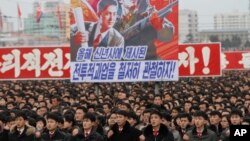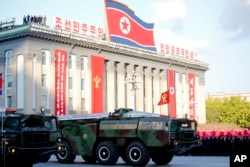Amid speculation surrounding North Korea's nuclear capabilities, the U.S. government said this week that Pyongyang has yet to acquire the ability to outfit an intercontinental ballistic missile with a nuclear warhead.
The latest assessment came after North Korean leader Kim Jong Un's statement that the preparations for launching an intercontinental ballistic missile had "reached the final stage." His claim, in a New Year's Day address, immediately sent ripples across the world's capitals, prompting President-elect Donald Trump to tweet, "It won't happen!"
Despite the U.S. rejection of North Korea's purported capability, experts are raising concern about the threats emanating from the regime.
Olli Heinonen, former deputy director-general of the International Atomic Energy Agency, told VOA that Pyongyang might be approaching or might have already hit a "milestone" in its arms development, after conducting five nuclear tests since 2006.
"If we look at the historical examples like Pakistan, India, China, Russia, France and the U.K., they, after five tests, started to have a nuclear weapon which they can deliver," the 27-year veteran of the IAEA said, "and I think the North Koreans have reached that milestone."
The most recent nuclear test, in September 2016, produced an explosive yield of around 20 to 30 kilotons, said Heinonen, adding, "That is very sizable."
Concerns about unknowns
According to Heinonen, "the unknowns" surrounding the North's nuclear and weapons programs are posing the greatest threat, because they make it difficult to determine current and future capabilities.
The size of North Korea's current stockpiles of highly enriched uranium and plutonium, its uranium enrichment capacity, and its progress in developing nuclear weapons and delivery systems are among the many things that are subject to uncertainties, he said.
Heinonen also maintained that additional, clandestine nuclear facilities of unknown scale could exist, other than the widely known Punggye-ri nuclear test site and Yongbyon nuclear reactor facility.
Another nuclear expert, David Albright, president and founder of the nonprofit Institute for Science and International Security, said North Korea already possessed the technical sophistication to miniaturize a nuclear warhead that could be placed atop a ballistic missile, and was on track to achieve substantial nuclear yield, probably in the 50-to-100-kiloton range.
"I think if you look at this technically, divorce yourself from the politics of Northeast Asia, you would have a hard time arguing that they didn't miniaturize [the nuclear warhead]," Albright said. "It would make them the worst nuclear program in the world, that after five nuclear tests they couldn't miniaturize."
The scientist also warned that North Korea could hold around 12 to 20 uranium-based nuclear weapons, and by 2020, it might have enough material to build as many as 80 nuclear weapons.
"They appear to have mastered fission weapons using plutonium or weapons-grade uranium," Albright said.
ICBM capability questioned
Jonathan McDowell of the Harvard-Smithsonian Center for Astrophysics raised doubts about the communist state's ability to launch an intercontinental ballistic missile with a nuclear warhead.
"I think that they are probably still five years away from an ICBM," said the astrophysicist, who tracks international satellites and rocket launchings. He said Pyongyang, whose intermediate-range missile tests mostly ended in failures, not only lacked in its basic launch technology, but also had not obtained upper-stage rockets, solid-fuel engines and the missile re-entry technology necessary for longer-range strikes.
On Thursday, North Korea's state-run news agency KCNA reiterated its position "to bolster a nuclear deterrence," accusing the U.S. of making a direct nuclear threat against the country.
Blinken: 'Qualitative improvement'
U.S. Deputy Secretary of State Antony Blinken told a joint news conference after a meeting with his Japanese and South Korean counterparts that North Korea had conducted 24 missile tests in the past year, as well as two nuclear tests, and learned from each one.
"Even a so-called failure is progress because ... they apply what they have learned to their technology and to the next test. And in our assessment, we have a qualitative improvement in their capabilities in the past year as a result of this unprecedented level of activity," he said.
"With every passing day the threat does get more acute," Blinken said, and referred to comments by North Korea's leader, Kim Jong Un, on Sunday that his country was close to test-launching an intercontinental ballistic missile (ICBM) of a kind that could someday hit the United States.
Blinken said it was vital for the United States, Japan, South Korea and other countries to boost cooperation to defend against the threat.
"At the same time, it's absolutely vitally important that we exercise sustained, comprehensive pressure on North Korea to get it to stop these programs, to come back to the negotiating table, and to engage in good faith on denuclearization," Blinken said, referring to international sanctions.
Lee Jee-eun and Reuters contributed to this report, which was produced in collaboration with VOA's Korean service.









